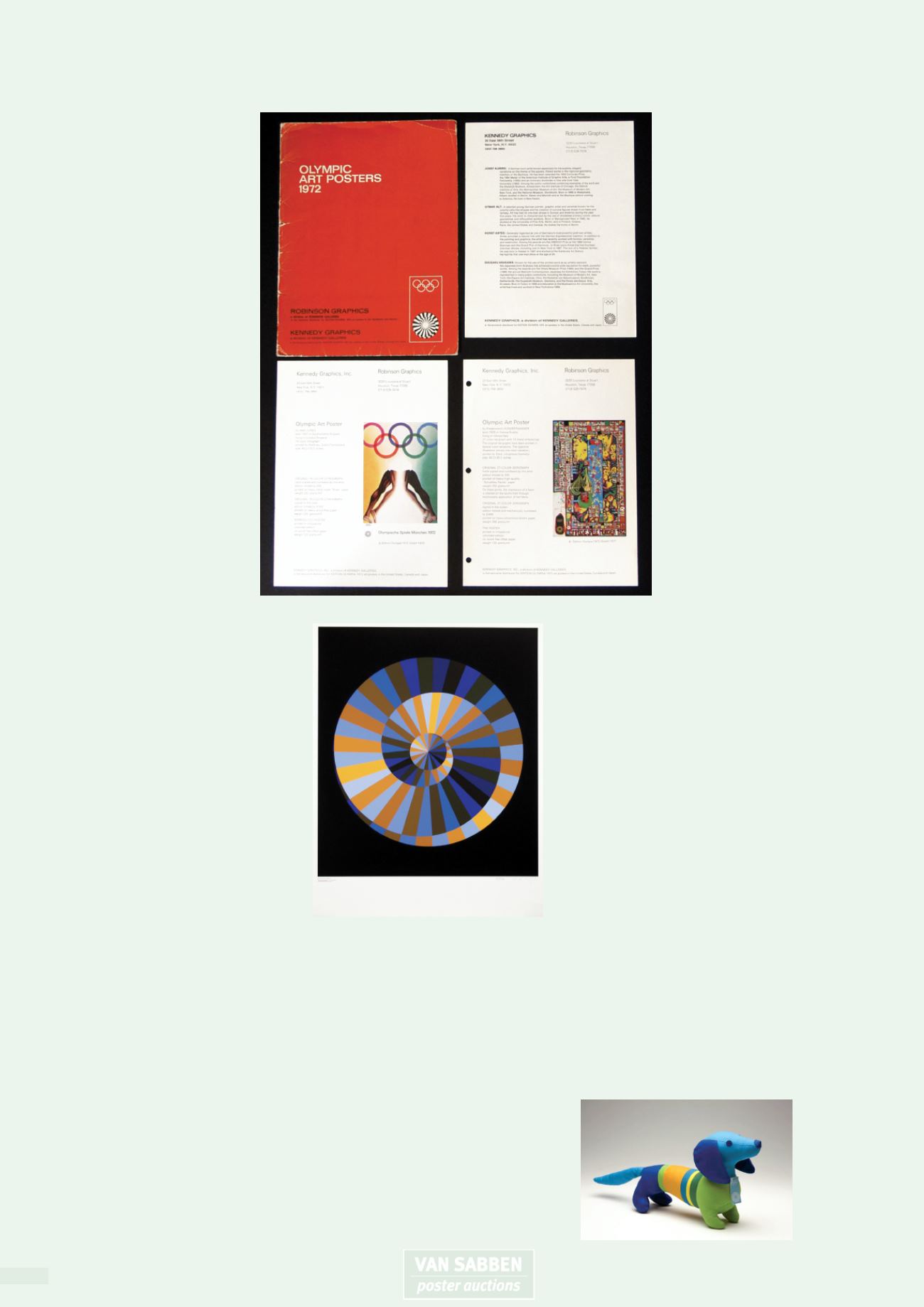
90
Complete collectie 1972 Olympische Spelen kunstenaar affiches, in gelimi-
teerde oplage van 200 exemplaren, gesigneerd en genummerd
De Olympische Zomerspelen van 1972
zullen vooral herinnerd worden door de
gijzeling van de Israëlische sportploeg
en het daarop volgende drama. Maar
ook uit grafisch oogpunt waren het bij-
zondere spelen. Affiches waren altijd al
een belangrijk communicatiemiddel
voor de Olympische Spelen, maar voor
de spelen van ’72 werd alles uit de kast
gehaald. Voor alle sportonderdelen en
randevenementen werd een ongekend
uitgebreid arsenaal affiches ontwor-
pen. Alles uitgevoerd onder leiding van
Otl Aicher in een uniforme stijl met
vaste kleurschema’s. Het werd één van
de tot dan toe meest uitgebreide corpo-
rate design campagnes, met een strikte
toepassing van ontwerpregels voor o.a.
affiches, programmaboekjes, beweg-
wijzering en uniformen. Ook het
ontwerp van pictogrammen voor de
diverse sportonderdelen werd geper-
fectioneerd en wordt tot op de dag van
vandaag
gebruikt.
Een
andere
nieuwigheid was de invoering van een
officiële mascotte, een teckel met de
naam Waldi.
Naast de affiches als communi-
catiemiddel, werden 28 van de op dat
moment toonaangevende kunstenaars
ingeschakeld om een serie kunstaffich-
es te ontwerpen. De affiches werden in
3 verschillende edities gedrukt: een
open editie van ca. 30.000 stuks ieder, een geli-
thografeerde editie in een oplage van 3.000 stuks
ieder en tot slot een editie van 200 stuks, die door
de artiesten (behalve Hockney) in potlood werden
gesigneerd en genummerd.
De volgende kunstenaars werkten mee: David
Hockney, Friedensreich Hundertwasser, Josef
Albers, Serge Poliakoff, Eduardo Chillida, Pierre
Soulages, Ronald Kitaj, Oskar Kokoschka, Tom
Wesselmann, Jan Lenica, Victor Vasarely (3
bladen), Max Bill, Allen Jones, Shusaku Arakawa,
Horst Antes, Paul Wunderlich, Charles Lapicque,
Otmar Alt, Hans Hartung, Jacob Lawrence, Valerio
Adami, Allan d´Arcangelo, Alan Davie, Fritz Winter,
Peter Philips, Piero Dorazio, Marino Marini.
De hiernaast aangeboden volledige set (lotnr.
659) komt uit de gelimiteerde editie van 200
stuks.
De affiches werden bij verschillende drukkers
gedrukt, zoals Mourlot, Kroll, Matthieu, Erker
Presse en Maeght. De gebruikte papiersoorten
waren o.a. 'Schoellers', 'Rives', 'Arches' en
'Chiffon de Mandeure'. De gebruikte druktech-
nieken lithografie en serigrafie. Het overgrote deel is handgesigneerd en
handgenummerd. Enkele bladen zijn niet genummerd en/of gesigneerd of
voorzien van EdA (Epreuve d'Artiste). De litho met het officiële embleem van
de Spelen (Kraft und Natur) door Vasarely is in 2 kleurvarianten aanwezig.
De meeste drukken werden individueel verkocht en raakten verspreid over de
gehele wereld. Waarschijnlijk is dit de enige complete set wereldwijd ver-
krijgbaar! Het blad met het Olympische logo in 2 kleurvariaties, in totaal 30
bladen.
Compleet met de oorspronkelijke verkoopbrochure door Kennedy Graphics
(New York) en Robinson Graphics (Houston), waarin 27 (het blad van
Hockney ontbreekt) bladen met afbeeldingen van de affiches, exacte
afmetingen, druktechnieken en papiersoorten. Bijgevoegd is een overzicht
met korte biografieën van elke kunstenaar.
The complete collection of the 1972 Olympic Games' art posters in a limi-
ted edition of 200 copies, signed and numbered.
The Olympic Summer Games of 1972 will
primarily be remembered for the Israeli
team being taken hostage and the sub-
sequent tragedy. Yet, these Games were
also special from a graphic point of view.
Posters had always been an important
means of communication for the
Olympic Games, but for the games of
’72 they really pushed the boat out. For
all sports and side events an unprece-
dented array of posters were designed.
All done in a uniform style with stan-
dardised colour schemes under the
supervision of Otl Aicher. It became one
of the most extensive corporate design
campaigns ever seen, with strict adher-
ence to design rules for posters, pro-
gramme booklets, signposts and uni-
forms. The designs of the pictograms
for the various sports were perfected as
well and those are still used to this day.
The introduction of an official mascot, a
dachshund named Waldi, was another
novelty.
Besides the posters which served as a
means of communication, 28 of the most
popular artists of that time were com-
missioned to design a series of art
posters. The posters were printed in
three different editions: an open edition
of approximately 30,000 copies each, a
lithograph edition of 3,000 copies and
finally an edition of 200 copies, hand
signed (except Hockney) and numbered in pencil by the
artists.
The following artists joined: David Hockney, Friedensreich
Hundertwasser, Josef Albers, Serge Poliakoff, Eduardo
Chillida, Pierre Soulages, Ronald Kitaj, Oskar Kokoschka, Tom
Wesselmann, Jan Lenica, Victor Vasarely (3 sheets), Max Bill,
Allen Jones, Shusaku Arakawa, Horst Antes, Paul Wunderlich,
Charles Lapicque, Otmar Alt, Hans Hartung, Jacob Lawrence,
Valerio Adami, Allan d´Arcangelo, Alan Davie, Fritz Winter,
Peter Philips, Piero Dorazio, Marino Marini.
The complete set offered on the next page (lot no. 659)
comes from the limited edition of 200 copies.
The posters were printed at various printers, including
Mourlot, Kroll, Matthieu, Erker Presse and Maeght. They used
printing techniques lithography and serigraphy on paper
types like 'Schoellers', 'Rives', 'Arches' and 'Chiffon de
Mandeure'. The majority were hand signed and hand num-
bered. Some sheets were numbered and/or signed or given
an EdA (Epreuve d'Artiste). The litho with the official emblem
of the Games (Kraft und Natur) by Vasarely is availbale in two
colour varieties.
Most prints were sold individually and got scattered all over
the world. This is possibly the only complete set available
worldwide! The sheet with the Olympic logo in two colour varieties, 30
sheets in total.
Complete with the original sales brochure by Kennedy Graphics (New York)
and Robinson Graphics (Houston), comprising 27 sheets (the sheet of
Hockney is missing) with pictures of the posters, the exact dimensions, prin-
ting techniques and paper types. A summary with a short biography of each
artist has been added.
Waldi, the official mascot for these games
© 2016 Rob van Vulpen
director Galerie Stylo
Official logo for the 1972 Games, V. Vasarely
Official sales brochure for this collection


